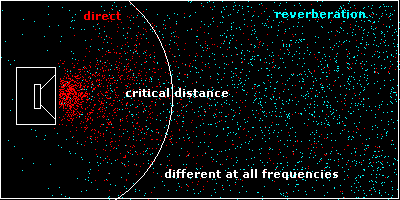"Know thy Critical Distance" is the 1st commandment of acoustics. Critical Distance is the distance from the sound source where the direct and reverberant sound energies become equal. The more reverberant a room is, the closer the Critical Distance is to the sound source. The more absorbent a room is, the further the Critical Distance is from the sound source. (Critical Distance is different at all frequencies).

For good acoustic design the Critical Distance should be as far as possible from the sound source and the resultant reverberation minimal and even at all frequencies. Direct sound from the speaker system diminishes in level as a function of the distance (inverse square law) whereas reverberation constantly spreads throughout the room. Because there is new incoming sound from the speakers reverberation keeps building up until the new incoming sound equals the sound absorbed (steady-state).

When the reverberant sound becomes 12dB or greater than the direct sound, all intelligibility is lost. The simplest way to find 'Critical Distance' is to play compressed pop music through the sound system. Begin with one speaker (left or right). Walk back and forth around the room, and you will be surprised how easy it is to identify the critical distance. Repeat this exercise with the other speaker, then both speakers. Its surprising how accurate our ears are when compared with acoustic measurement microphones.
- The more reverberant the room is the closer the Critical Distance.
- The more absorbent the room is the further the Critical Distance.
- Near field or Direct field is inside the Critical Distance.
- Far field or Reverberant field is outside the Critical Distance.
Critical Distance: Dc = 0.14/√QR (Q = directivity factor 1 of sound source. R = room constant)


